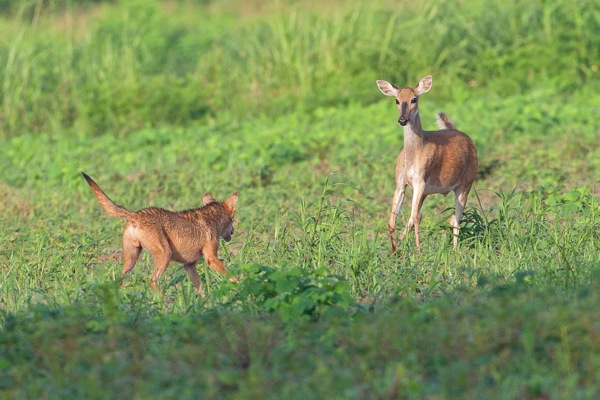Coyotes and deer coexisted in Georgia for more than 30 years. So why does their coexistence seem to be such a big issue now?
In the early and mid-2000s, the deer population began declining. Research on a handful of properties revealed interesting impacts of coyote predation on fawn recruitment, or the number of fawns per doe that survive or are “recruited” into the fall population. It’s also generally accepted that coyote abundance increased across the state during this time.
The correlation between fewer deer and more coyotes may seem to be a direct cause and effect relationship, but there are other factors at play. Although coyote predation on fawns can be factor, the decrease in the deer population largely resulted from increased harvest because of public desires to reduce the deer density in most regions. Georgia’s Deer Management Plan 2005-2014 was a direct reflection of this desired trend.
Current science-based research in Georgia indicates that the impact of coyotes is highly variable and can vary widely on properties that are close together. Coyotes are very mobile and have home ranges that can cover thousands of acres. This may contribute to high variation in impacts on fawn recruitment from area to area and even on the same property from year to year.
If you believe coyotes are a concern where you hunt, what can you do? Trail camera surveys are an excellent way to estimate fawn recruitment and evaluate whether a problem exists. Professional wildlife biologists with WRD are available, as are private biologists, to help you set up a survey and assess the data.
If coyote predation is a problem, the first step is to evaluate your doe harvest. Doe harvest may be contributing to a decrease in deer density as much as, or more than, other predators. In most cases, reducing the doe harvest, or even temporarily eliminating it, may solve the problem.
If coyote removal is needed, the most effective method is intensive trapping immediately before and during fawning. When coyotes are killed during deer season or trapped in January, transient coyotes quickly move in and fawn recruitment will likely not improve.
While coyotes are a management issue for deer managers to consider, hunters kill four deer for each deer a coyote kills. Humans are the dominant predator on deer. Coyotes can have an influence, but they will not be the end of deer hunting in Georgia.
Photo: Steve Creek, Wildlife Photographer



















![The Best Deer Camp Chili [VIDEO] Deer Chili Ingredients, Tomatoes, Chili Spices](/wp-content/uploads/2015/10/Deer-Chili-Deer-Camp-Recipe-218x150.jpg)
![How to Call Elk Early in the Season [VIDEO]](/wp-content/uploads/2016/08/byers003-218x150.jpg)




![Idiots Disturb Hunter: How Would You Have Handled It? [VIDEO]](/wp-content/uploads/2015/10/DSC00110-e1474487693878-100x70.jpg)
![Albino Buck Shocked to Shed His Antlers [VIDEO]](/wp-content/uploads/2015/10/AlbinoDeer-100x70.jpg)